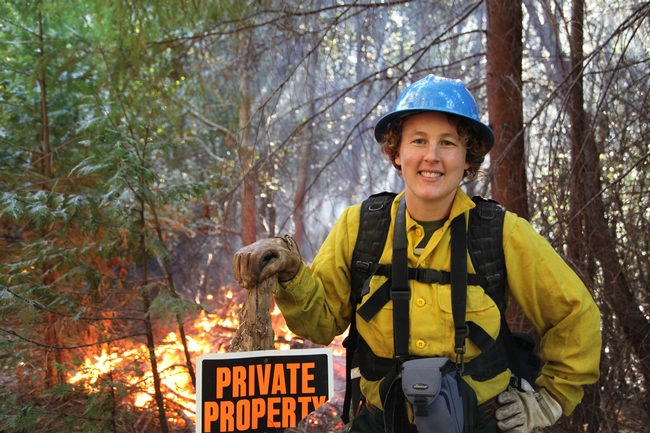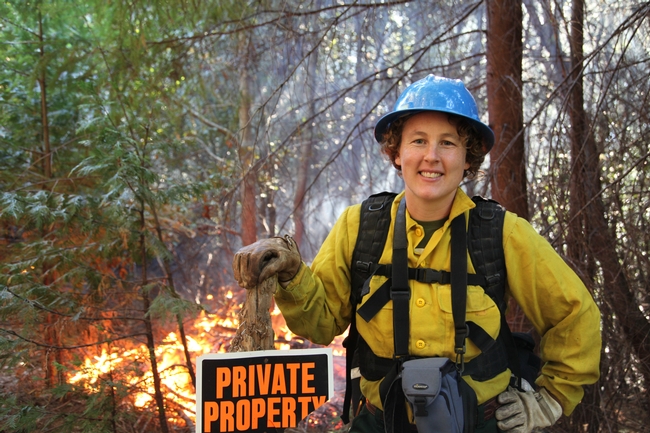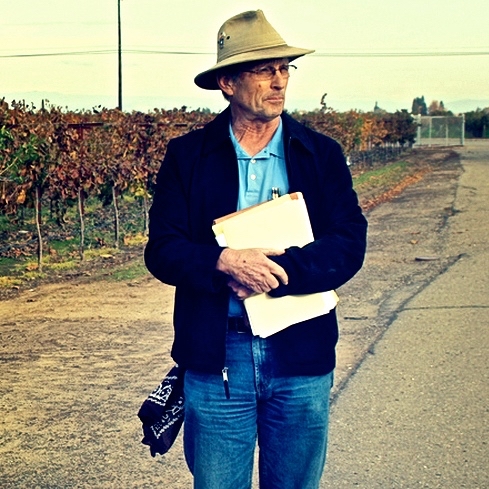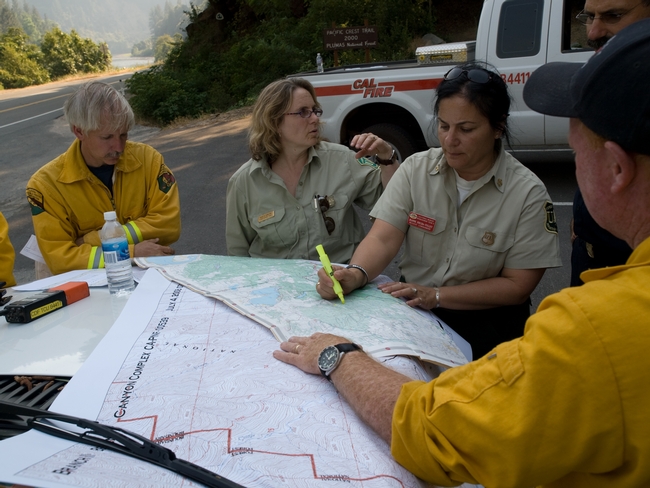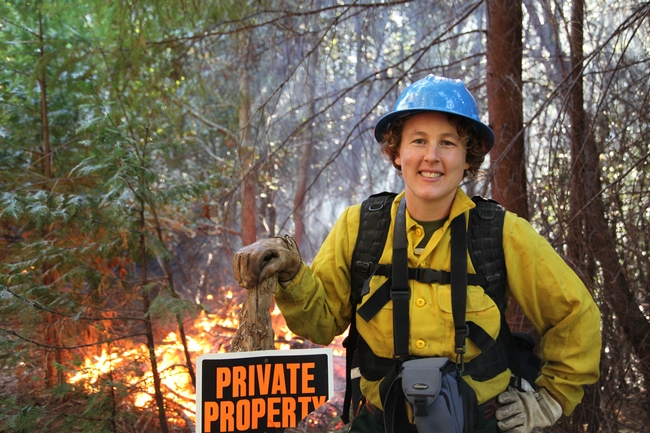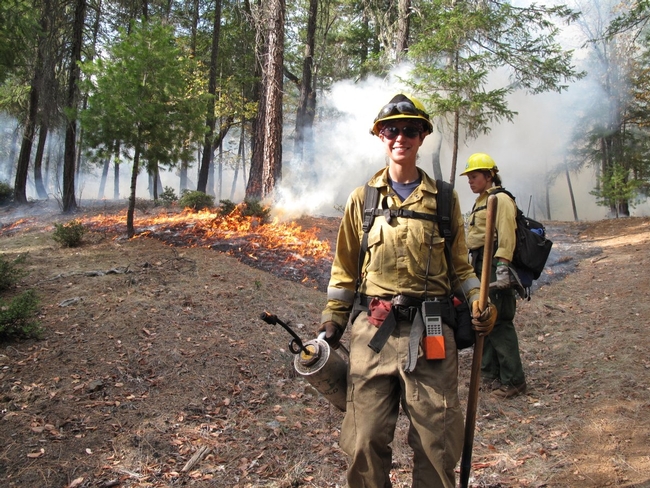Posts Tagged: Lenya Quinn-Davidson
August 2018 News Clips 8/1-8/15
UC: Tariffs could cost fruit, nut industries over $3 billion
(Farm Press) Aug. 15
A new report released by the University of California Agriculture and Natural Resources' Agricultural Issues Center estimates the higher tariffs could cost major U.S. fruit and nut industries $2.64 billion per year in exports to countries imposing the higher tariffs, and as much as $3.34 billion by reducing prices in alternative markets.
https://www.westernfarmpress.com/tree-nuts/uc-tariffs-could-cost-fruit-nut-industries-over-3-billion
Evacuation priorities: Save people first, then livestock
(Ag Alert) Kathy Coatney, Aug. 15
"It's generally too difficult to get trucks out on such a short notice," said Glenn Nader, University of California Cooperative Extension livestock and natural resources advisor emeritus for Butte, Sutter and Yuba counties.
… Carissa Koopmann Rivers, UCCE livestock and natural resources advisor for Siskiyou County, said the Klamathon fire, first reported in early July, devastated the town of Hornbrook, which is situated in a cattle-producing area.
…Ricky Satomi, UCCE forestry advisor for Shasta, Trinity and Siskiyou counties, said if there's a wildfire and a person has advanced notice, there are several things that can be done to save buildings before evacuating.
http://agalert.com/story/?id=12106
Tariffs Could Cost California Growers Billions
(Growing Produce) Christina Herrick, Aug. 15
A new study from the University of California Agriculture and Natural Resources' Agricultural Issues Center finds that tariffs on 10 fruit and tree nut exports alone are estimated to cost the U.S. $3.4 billion annually.
https://www.growingproduce.com/nuts/tariffs-cost-california-growers-billions/
Interior Secretary: Environmental policies, poor forest management to blame for wildfires
(Circa) Leandra Bernstein, Aug. 14
…"Together, poor land management, poor land use planning and the onset of climate change, we have created the perfect environment for the perfect firestorm in California. It's completely expected and it's going to get worse," explained Dr. Kate Wilkin, a fire scientist at the University of California Cooperative Extension.
Looming Chlorpyrifos Ban Has ‘Natural' Pesticide Makers Buzzing
(Bloomberg) Tiffany Stecker, Aug. 14
...Alternatives may be available, but they lack the punch of chlorpyrifos, which kills multiple pests at once, Beth Grafton-Cardwell, a scientist working with citrus farmers as part of the University of California Cooperative Extension, told Bloomberg Environment.
https://www.bna.com/looming-chlorpyrifos-ban-n73014481691/
Fierce and Unpredictable: How Wildfires Became Infernos
(New York Times) Jim Robbins, Aug. 13
…Triple-digit temperatures “preheat the fuels, and it makes them much more receptive to igniting,” said Scott L. Stephens, a fire ecologist at the University of California, Berkeley.
https://www.nytimes.com/2018/08/13/science/wildfires-physics.html
In California's new wildfire reality, facing the need for periodic fires to clear fuel
(SF Chronicle) Kurtis Alexander, Aug. 13
While misguided forest- management policies are just one reason that fire has become more devastating, a warming climate and more development in California's wildlands also contribute, making planned burning vital, said wildfire specialist Max Moritz with UC's Division of Agriculture and Natural Resources.
“We need to become more comfortable with fire as a tool,” he said. “Prescribed fire could do a lot of good, restoring these forests to healthy conditions and reducing the fire hazard.”
8/13/18 Trade Tensions
(NewsTalk 780 KOH) Jon Sanchez Show, Aug. 13
Daniel Sumner, director of the UC Agriculture Issues Center, discussed the impact of trade tariffs on agriculture and U.S. economy with Jon Sanchez
https://www.spreaker.com/user/10565136/sanchez0813
UCCE Manure Nitrogen Study Update in Dairy Feed Crops
(California Dairy Magazine) Aug. 10
It takes time for the nitrogen found in dairy manure water to become available to feed crops out in the field, and as dairy producers don't want to under or over fertilize their feed crops, the UC Cooperative Extension is conducting a research trial to find out more regarding how manure water interacts in the soil with plant root systems. Watch this brief interview UC Agronomy Advisor Nicholas Clark as he summarizes a recent presentation he shared at the Golden State Dairy Management Conference.
Trees vital as heat waves ravage Southland, experts and L.A. officials say
(Hub LA) Hugo Guzman, Aug. 10
…Researchers with the University of California Cooperative Extension are helping do just that. In partnership with the United States Forest Service, researchers there have launched a 20-year study to identify trees that can withstand higher temperatures and lower rainfall. Native trees such as the Catalina Cherry and Ironwood trees, along with imports like Ghost Gum and Acacia trees, could form the future of L.A.'s canopy.
http://www.hub-la.com/news/trees-heat-waves-ravage-southland-officials/
Elkus Ranch brings kids to nature
(Half Moon Bay Review) Max Paik, Aug. 8
“I think it's important that the children get to see what it takes to care for farm animals … from the cute to the somewhat smelly,” said Igor Lacan, environmental horticulture adviser with the University of California Cooperative Extension, which runs the ranch.
What These Wildfires Say About Climate Change
(OnPoint NPR) Eric Westervelt, Aug. 8
Guests
- Daniel Berlant, assistant deputy director of Cal Fire, the state's fire agency.
- Ryan Lillis, reporter for the Sacramento Bee. He has covered most of Northern California's fires for the last 12 years. (@Ryan_Lillis)
- Lenya Quinn-Davidson, area fire adviser with the University of California's Cooperative Extension, which works with counties and communities in the state on managing the threat of wildfires. Northern California coordinator of the California Fire Science Consortium. (@lenyaqd)
Michael Mann, professor of atmospheric science and director of the Earth System Science Center at
Pennsylvania State University. Co-author of "The Madhouse Effect: How Climate Change Denial is Threatening Our Planet, Destroying Our Politics, and Driving Us Crazy." (@MichaelEMann)
http://www.wbur.org/onpoint/2018/08/08/mendocino-complex-wildfires-california-climate-change
Drought may be increasing camel cricket numbers
(Farm Press) Tim Hearden, Aug. 8
A few years ago, University of California viticulture and pest management advisors noticed unusual leaf symptoms in certain Napa County hillside vineyards that were right next to oak woodlands.
As described by the UC Cooperative Extension's Monica Cooper and Lucia Varela, the feeding activity they noted in April 2015 resulted in a “lace-like” appearance to damaged leaves. Then last year, in March, they observed feeding damage to expanding buds.
… Where vineyards have come into play is when they were situated on hillsides next to oak woodlands and mixed species of white alders, madrone, California bay, and Douglas fir, according to Varela, a north coast integrated pest management advisor, and Rhonda Smith, a UCCE viticulture advisor.
https://www.westernfarmpress.com/grapes/drought-may-be-increasing-camel-cricket-numbers
Yes, humans have made wildfires like the Carr fire worse. Here's how.
(Washington Post) Sarah Kaplan, Aug. 8
…Many forests in the western United States are “fire adapted” said Scott Stephens, a fire ecologist at the University of California at Berkeley. Natural wildfires every 5, 10 or 20 years help clear debris from the forest floor and make room for stronger, healthier trees.
…Wildfires are as unstoppable as hurricanes, Stephens said — and much like hurricanes, increasingly inevitable as the climate changes. “But you could do a lot more when you're getting ready for fire to inevitably occur,” he said. By building with fire-safe materials, establishing buffer zones between ecosystems and communities, and better caring for forests before fire season starts, some of the destructiveness of fires could be mitigated, Stephens said.
The staggering scale of California's wildfires
(New York Times) Lisa Friedman, Jose A. Del Real, Aug. 8
…Lisa: Mr. Trump in his tweet referred to the longstanding dispute between California farmers and environmentalists over the allocation of the state's precious water resources. Both sides want more and Mr. Trump has embraced the arguments of the agriculture community.
But William Stewart, a forestry specialist at the University of California, Berkeley said leaving less water for fish would have no impact on amount available for fighting fires. That water comes from local streams and rivers, where water-dropping helicopters drop their buckets. Neither he nor other scientists could point to a scenario in which California's environmental laws have prevented or curbed the use of water to fight wildfires.
https://www.nytimes.com/2018/08/08/us/california-today-fires-and-climate.html
California giving out $170 million in cap-and-trade revenue to help prevent wildfires
(San Francisco Chronicle) Kimberly Veklerov, Aug. 8
…Groups in six Bay Area counties will get a combined $7.4 million. The biggest portion of that, $3.6 million, will go to UC Berkeley. The Federal Emergency Management Agency in 2016 withdrew what would have been an award of roughly the same amount to thin and remove eucalyptus trees in the East Bay hills after a lawsuit by conservation activists.
…Keith Gilless, chairman of Cal Fire, said the state needs to do much more vegetation management — activities like reducing hazardous plant fuels — to address wildfire risk.
“One of the things we need in California moving forward is striking a better balance between carbon sequestration in forests and the risk associated with that densely stocked carbon sequestration,” said Gilless, also a UC Berkeley professor of forest economics. “We need to figure out ways to do vegetation management that are socially acceptable with the smallest public subsidy possible.”
These California counties have the highest concentration of homes vulnerable to wildfire
(Sac Bee) Michael Finch II, Aug. 7
In the case of the northern counties, the risk will be higher because homes there often dispersed at the edge of a wildland area, said Lenya Quinn-Davidson, a Eureka-based fire advisor for the University of California Division of Agriculture and Natural Resources.
“Those areas that you mentioned are areas that have a lot of homes mixed into the wildland-urban interface — areas where there are a lot of homes that are edgy and in the forest and have a lot of fuel.”
https://www.sacbee.com/news/state/california/fires/article216076320.html#storylink=cpy
Can More Logging Help Prevent California Wildfires?
(KQED) Forum, Aug. 7
Cal Fire officials announced yesterday that the Mendocino Complex fire grew to over 283,000 acres, making it the largest in state history. As wildfires across the state rage on, Governor Brown and some lawmakers are calling for increased forest thinning to lessen the threat posed by fires. Those in favor of logging say that removing trees and vegetation can help reduce a fire's intensity and make forests more resilient. Opponents say thinning does nothing to protect communities from fires and imperils species that depend on dense forests. We'll take up the debate.
Guests:
Chad Hanson, director, John Muir Project of Earth Island Institute ; co-author, "Nature's Phoenix: The Ecological Importance of Mixed-Severity Fires"
Molly Peterson, reporter on assignment for KQED News
Scott Stephens, professor of fire science at the College of Natural Resources, UC Berkeley
Rich Gordon, president and CEO, California Forestry Association, former assemblymember representing California's 21st district
Jim Wood, assemblymember for district 2, Sonoma County, a member of the Senate and Assembly conference committee on wildfire preparedness and response
https://www.kqed.org/forum/2010101866607/can-more-logging-help-prevent-california-wildfires
Trump wants to clear more trees to halt fires. The feds need to spend more, experts say.
(Sac Bee) Emily Cadei and Kate Irby, Aug. 7
“I think for a number of years the feds were more ahead of this dilemma, at least in discussions,” said Scott Stephens, a professor of fire science at the University of California, Berkeley. But “I have to say right now, I think the state is moving ahead. It's certainly being more innovative, it's doing more policy work.”
https://www.sacbee.com/news/politics-government/capitol-alert/article216160995.html
Trump says California's water policies are making the wildfires worse. Is he right?
(Sac Bee) Dale Kasler, Aug. 6
William Stewart, a forestry management expert at UC Cooperative Extension, agreed. “The entity that's doing the worst job are the people working for him,” Stewart said, referring to Trump.
Stewart said the Carr Fire, which killed seven people and forced mass evacuations in and around Redding, started in shrub and grasslands west of the city, not in the forests. Only lately, after the threat to Redding abated, has the fire moved north onto Forest Service land and forested property owned by Sierra Pacific Industries, he said.
https://www.sacbee.com/news/politics-government/capitol-alert/article216181625.html
California Groundwater Law Means Big Changes Above Ground, Too
(Water Deeply) Matt Weiser, Aug. 6
The best groundwater recharge areas have certain soil types that are good at absorbing water. These areas have already been mapped by, among others, the California Soil Resource Lab at the University of California, Davis. [Tobi o'Geen's lab]
Cal Fire responds to President Trump's tweet about state wildfires
(ABC7) Rob McMillan, Aug. 6
Cal Fire and a researcher from UC Riverside responded to Donald Trump's tweet related to the state's wildfires on Monday.
"Thinning would be a good idea, but the question is how you thin properly," UC Riverside's Dr. Richard Minnich said.
"There are too many trees in the ground sucking the ground dry. That's one of the reasons you had so many trees die in the Sierras."
But Minnich says that there is plenty of water in California. Shasta is the biggest reservoir in the state and it's currently more than two-thirds full.
https://abc7.com/politics/cal-fire-responds-to-president-trumps-tweet-/3896820/
California Wildfires: It's a people problem
(East Bay Times) Lisa Krieger, Aug. 5
Even as fires rage across California, thousands of new homes are being built deeper into our flammable foothills and forests, as lethal as they are lovely.
A big reason why: It's harder to do controlled burns — one of the most effective fire suppression techniques — near residential areas, due to smoke concerns. Until the 1970's, fire suppression tended to minimize fire spread.
“If homes are sprinkled through the landscape, you take that key tool off the table,” said Max Moritz, a wildfire specialist with UC's Division of Agriculture & Natural Resources.
https://www.eastbaytimes.com/2018/08/05/california-wildfires-its-a-people-problem/
Report: Future climate could affect street trees
(Turlock Journal) Kristina Hacker, Aug. 3
Eighty-one years from now, Turlock's climate could resemble more of southeast California's high desert areas, according to a new report that says inland California municipalities should consider increasing temperatures due to climate change when planting street trees.
…"Urban foresters in inland cities of California should begin reconsidering their palettes of common street trees to prepare for warmer conditions expected in 2099 due to climate change," said the study's co-author, Igor Lacan, UC Cooperative Extension environmental horticulture advisor in the Bay Area.
https://www.turlockjournal.com/news/local/report-future-climate-could-affect-street-trees/
Wildfires force California to reckon with a not-so-new normal
(Christian Science Monitor) Martin Kuz, Aug. 3
…The committee's focus on improving utility grid safety and examining the liability of power companies reflects the causes of several blazes in 2017. The absence of land use planning from its agenda suggests what Max Moritz, a wildfire specialist at the University of California, Santa Barbara, describes as a “political will problem.”
“If you want to keep communities safe, then you have to think about living differently, about where and how we build our communities,” he says. “But there's no bill in the legislature about that.”
Will smoke taint summer harvests in the Mother Lode?
(The Union Democrat) Giuseppe Ricapito, Aug. 3
Drift smoke from the Ferguson Fire has some Tuolumne County vintners and agriculturalists concerned about the commercial viability of the early fall grape harvest, but one forestry official with the University of California noted that the native wilderness of the Mother Lode has a developed adaptability to smoky conditions.
Susie Kocher, forestry and natural resources advisor with the University of California Department of Agriculture and Natural Resources Central Sierra Cooperative Extension, said that “smoke taint” of commercial agriculture was always a concern during fire season.
“It's grapes we worry about the most,” she said. “In the past there have been bad years when there was a lot of smoke where grapes were on the vine and wineries had to produce the smoky wine because of that effect.”
https://www.uniondemocrat.com/localnews/6425094-151/will-smoke-taint-summer-harvests-in-the-mother
Coyote encounters expected to rise during heat and drought
(ABC 10) Jared Aarons, Allison Horn, Aug. 2
The record-breaking heat and drought are forcing animals, including coyotes, out of their natural habitats and closer to humans…
The University of California Coyote Catcher website tracks sightings and attacks. Their figures for 2018 show coyote incidents are down compared to last year. In 2017, there were 142 coyote attacks. More than halfway through 2018, San Diego is on track to stay below that number, with 64 attacks.
According to the website, there have been six reported pet deaths this year.
https://www.10news.com/news/coyote-encounters-expected-to-rise-during-heat-and-drought
Backyard chickens are dying in droves in SoCal. Will disease spread to Valley?
(Fresno Bee) Robert Rodriguez, Aug. 2
Maurice Pitesky, a veterinarian and University of California extension specialist in the School of Veterinary Medicine at UC Davis, said backyard chicken owners should closely watch their flocks.
Symptoms include, sneezing, coughing, green watery diarrhea, neck twisting, paralysis, decreased egg production and swelling around the eyes and neck.
https://www.fresnobee.com/news/business/agriculture/article215859875.html
Growers prepare for smaller prune harvest
(Farm Press) Tim Hearden, Aug 2
…With guidance from University of California Cooperative Extension advisors, growers have been paying close attention to tree water stress and sugar levels in the weeks leading up to the harvest, which was expected to begin in about the third week of August.
… “It's probably going to vary a little bit because the cropping is really variable,” UCCE advisor emeritus Rick Buchner says of the prune crop. “Some of it is good and some is really light. We had a heck of a time pollinating them.”
…“Harvest can be a nerve-wracking time in the prune business,” UCCE advisors Franz Niederholzer and Wilbur Reil note in a California Dried Plum Board blog post. “The finish line – when the entire crop is in the bins – may be in sight, but here are still tough decisions to be made that influence your bottom line.”
…In general, harvest can be expected roughly 30 days after the first healthy fruit in an orchard starts changing color, UCCE orchard advisor Katherine Jarvis-Shean explains in a separate blog post. She urged growers to time their irrigation cut-off to improve dry-away ratios, reduce premature fruit drop and decrease shaker bark damage at harvest.
https://www.westernfarmpress.com/orchard-crops/growers-prepare-smaller-prune-harvest
Researchers look at ways to improve onion yields
(Ag Alert) Padma Nagappan, Aug. 1
Jairo Diaz-Ramirez and five other scientists have recently completed year two of an irrigation trial for onions, testing furrow and drip irrigation, and found that their methods produced good results, without water distress or soil tension. They tested the Taipan variety of onions.
http://agalert.com/story/Default.aspx?id=12068
The California fires situation is concerning, but not hopeless
The news that Americans are getting about California's devasting fires is not being hyped up by the media, said UC Cooperative Extension area fire advisor Lenya Quinn-Davidson on the nationally broadcast NPR program On Point.
Host Eric Westervelt of WBUR in Boston got a Northern California perspective from Quinn-Davidson, who works with communities in Siskiyou, Trinity and Mendocino counties on managing the threat of wildfires and is the Northern California coordinator of the California Fire Science Consortium.
"I definitely don't think the situation is being hyped up," Quinn-Davidson said. "I'm in Ukiah and there's a thick blanket of smoke. Everyone can feel the tension of the Mendocino Complex Fire."
Quinn-Davidson said she grew up in the vicinity and, back then, major fires like those burning today only happened every few years. Lately, such super fire seasons are happening every year. She said it's time for Californians to take a different approach when thinking about fire.
"Fire is the only natural disaster that we fight against," Quinn-Davidson said. "With hurricanes and earthquakes, we adapt and try to identify vulnerabilities and change our behavior. We haven't treated fire like that. We need to learn how to adapt and make changes that make us more resilient to fire."
On Point is NPR's only call-in program. One caller asked whether climate change has reached an irreversible tipping point at which little can be done to reverse the damage that is causing extreme flooding, heat, hurricanes and wildfires.
Quinn-Davidson said she offers hope to the people in communities she serves.
"They're not powerless," she said. "I don't want people to feel that we are beyond some tipping point and they should just throw in the towel. I think we need to feel empowered to make the changes we can make - whether on a personal scale, at at the mid-grade community scale, or if it is taking political action to make larger change ... We still have some place to make a difference. I really believe that."
Michael Mann, professor of atmospheric science and director of the Earth System Science Center at Pennsylvania State University, was also a guest on the On Point program. He said that, as a nation, we may have breached a different tipping point - a tipping point in public consciousness. Recent news reports have informed the public about extreme flooding in Japan, record-breaking heat in Europe and catastrophic wildfires in California.
"This summer has made a difference in the public perception of how profound the threat of climate change already is," Mann said. "And I like to think that when they go to the voting booths in less than 100 days, they're going to be thinking about climate change and the need to act on this problem. I think we will see progress."
Utility to turn off power when fire risk is high
During periods of "extreme fire conditions," PG&E will shut off electric power lines to prevent wildfires, reported Dale Kasler in the Sacramento Bee.
The reporter spoke to Lenya Quinn-Davidson, UC Cooperative Extension area fire advisor in Northern California, about the utility's proposed actions. She said PG&E will have to give communities plenty of advance warning before turning off power so residents aren't left without a means of receiving emergency information.
"They're going to have to do a lot of good community outreach so people will be prepared," she said. Still, she called it "a reasonable short-term solution while they're figuring out other things" to reduce fire risks.
Monthly news round up: January 2018
Woodland as ag hub topic of forum
(Woodland Daily Democrat) Jenice Tupolo, Jan. 30
Developing Woodland as an agricultural center is becoming more of a reality, even as local organizations worked together in creating a forum focused on agricultural innovation in Yolo County.
...The city of Woodland, AgStart, UC Agricultural and Natural Resources, and the city's Food Front initiative hosted keynote speaker and vice president of the UC ANR, Glenda Humiston, at the conference.
http://www.dailydemocrat.com/business/20180130/woodland-as-ag-hub-topic-of-forum
Small Farmers in Fresno Hope for Big Moringa Payoff
(KQED) Katrina Schwartz, Jan. 26
The Mouas, along with other Hmong farmers growing moringa, have been working with farm advisers at Fresno County's UC Cooperative Extension to learn how to dry, powder and store their moringa so they can expand into new markets. Most farmers sell it fresh, but most of the health food craze exists around moringa powder, often imported from India.
… “Value-added products are a great way for a small family farm to increase their income,” said Ruth Dahlquist-Willard, a small-farm adviser with the program. Many farmers are accustomed to only selling fresh produce. They plant a diverse set of crops in a small area and sell a little bit of everything. Producing a product that requires the extra step of drying, grinding and storing is a whole new world for many of them.
“I think there's a lot of opportunity there,” Dahlquist-Willard said. She's particularly excited about how a product might bring the younger generation back to their family farms. Kids who have gone off to college for business, marketing or graphic design might see a new kind of future for themselves on the family farm with a product like moringa.
https://ww2.kqed.org/news/2018/01/26/small-farmers-in-fresno-hope-for-big-moringa-payoff/
SLO County's Top 20 Under 40: Meet the 2017 award winners
(San Luis Obispo Tribune) Staff, Jan. 26
…Katherine E. Soule, 35, is director of the UC Cooperative Extension for SLO and Santa Barbara counties, where she's earned state and national recognition for improving community health and increasing diversity in youth participation.
As the extension's youth, families and communities advisor for the last several years, Soule developed new 4-H programs engaging underserved youths and promoting healthy living, leadership and social development. Her efforts nearly doubled enrollment and boosted Latino participation 26.8 percent. She's delivered nutrition education to more than 10,000 people through various partnerships.
http://www.sanluisobispo.com/news/business/article196536784.html
Flooding alfalfa for groundwater recharge
(Morning Ag Clips) Jan. 24
A rigorous field study in two California climate zones has found that alfalfa can tolerate very heavy winter flooding for groundwater recharge. The research was published online Jan. 16 in California Agriculture journal.
The alfalfa research is the latest in a series of projects studying the effects of using land planted with permanent crops – including almond orchards and vineyards – to capture and bank winter storm water. Such projects have great promise but also require collaboration across multiple jurisdictions and agencies. UC Agriculture and Natural Resources vice president Glenda Humiston has made groundwater recharge on working lands and open spaces a division priority and is working with water and land use leaders around the state to facilitate it through policy recommendations and cross-agency collaboration.
https://www.morningagclips.com/flooding-alfalfa-for-groundwater-recharge/
Band Canker Affecting Younger Almonds
(California Ag Today) Patrick Cavanaugh, Jan. 24
Brent Holtz is a UC cooperative extension Pomology Farm Advisor for San Joaquin County. He recently told California Ag Today about how the fungus band canker on almonds is becoming more prevalent in the San Joaquin Valley.
“I've seen a lot more band canker, which is caused by a pathogenic fungus, Botryosphaeria dothidea, and we're seeing it on young orchards, especially in in San Joaquin county," said Holtz. "We've seen that a lot out in the delta and we've seen it in eastern San Joaquin county where the soils tend to be a little heavier, maybe old dairy ground and richer and we don't really know why."
https://californiaagtoday.com/band-canker-affecting-younger-almonds/
CCOF Annual Conference to Focus on Organic Hotspots
AgNet West) Jan. 22
Registration is available for the California Certified Organic Farmers (CCOF) annual conference, Organic Hotspots: Revitalizing Rural America. The event is scheduled for February 22 and 23 at the Sheraton Grand Sacramento Hotel in Sacramento.…
The event will focus on organic hotspots and how rural economies can potentially be stimulated by organic production. Topics will include partnerships between elected officials and the organic community, the role of education and research, along with the process of growing organic produce in local communities. The event will conclude with a keynote speech from Glenda Humiston, Vice President of the University of California Division of Agriculture and Natural Resources.
http://agnetwest.com/ccof-annual-conference-organic-hotspots/
California Today: 100 Million Dead Trees Prompt Fears of Giant Wildfires
(New York Times) Thomas Fuller, Jan. 19
The more than 100 million trees that died in California after being weakened by drought and insect infestations have transformed large swaths of the Sierra Nevada into browned-out tree cemeteries. In some areas more than 90 percent of trees are dead.
This week a group of scientists warned in the journal BioScience that the dead trees could produce wildfires on a scale and of an intensity that California has never seen.
…“It's something that is going to be much more severe,” said Scott Stephens, a professor of fire science at Berkeley and the lead author of the study. “You could have higher amounts of embers coming into home areas, starting more fires.”
Winter's good time for gopher control in nut crops
(Western Farm Press) Cecelia Parsons, Jan. 17, 2018
Tree nut growers who are plagued by gopher invasions in their orchards need to stick with effective control measures if they want to minimize tree losses.
Pocket gophers are common in most nut production areas, says Joe Connell, University of California Cooperative Extension Farm Advisor Emeritus in Butte County. In the absence of cover crops or weeds, they will gnaw on tree roots and trunks, and the hungry vertebrate pests can even girdle — and kill — older trees. Trees with root damage and girdling will lose production, and will be susceptible to crown gall, which weakens their structural strength.
http://www.westernfarmpress.com/tree-nuts/winter-s-good-time-gopher-control-nut-crops
Bloomington nursery's citrus trees to be destroyed by California agriculture department
(ABC7 KABC) Rob McMillan, Jan. 17, 2018
Roxana Vallejo was 12 years old when her parents opened up Santa Ana Nursery in Bloomington. Wednesday, the California Department of Food and Agriculture will be at her business to destroy almost all of their citrus trees. Vallejo said the combined value of the trees is almost $1 million.
"They're all fine, and look at all the new growth, it's pretty good," Vallejo said.
The reason they're being cut down is huanglongbing, or HLB, one of the world's worst citrus diseases. The insect that spreads HLB has taken a strong foothold in Southern California.
"It's estimated that the citrus industry may go commercially extinct unless they can get a handle on this problem," said Mark Hoddle, UC Cooperative Extension specialist at UC Riverside, more than one year ago.
http://abc7.com/food/ie-nurserys-citrus-trees-to-be-destroyed-by-ca-agriculture-department/2959173/
OPINION: Ranchers give thanks
(Ventura County Star) Beverly Bigger, president of the Ventura County Cattlemen's Association, Jan. 16, 2018
The majority of attention and sympathy have rightly gone toward those who lost their homes in the Thomas Fire, but I would like to take a moment to highlight the story of others who have suffered as well. They are largely invisible, hidden among the hills and canyons, but their contribution to the county is significant.
Ventura County is home to a robust and historic cattle industry, one that makes up a $2 million portion of Ventura County's agricultural sector. Ranchers play an important role in land management as well, their grazing operations clearing overgrown brush, reducing the fuel available to wildfires and protecting nearby communities.
In the space of 12 hours, the Thomas Fire ripped through vital grazing land that cattle rely on for their daily feed. Sadly, some animals were also lost to the fire.
With feed and fencing gone, many ranchers had hard decisions to make regarding the future of their operations, and some were not prepared for this kind of disaster. Thankfully, we have dedicated public servants who stepped up to help the cattle industry.
Ventura County Agricultural Commissioner Henry Gonzales, Matthew Shapero from the UC Cooperative Extension, and Donna Gillesby and Bryan Bray of Ventura County Animal Services all reached out to ask what they could do to help.
An emergency program was put in place to supply five days of hay until ranchers could get on their feet. The UC Extension also provided a one-stop location where ranchers could meet with representatives from multiple agencies to apply for assistance programs.
The assistance of these agencies was very much appreciated. We want to thank and recognize them for helping us in our time of need. We look forward to returning to our passion: managing and improving the land and continuing Ventura County's ranching heritage.
http://www.vcstar.com/story/opinion/readers/2018/01/16/ranchers-give-thanks/1038625001/
Farm advisor tests strategies for controlling horseweed
(Ag Alert) Bob Johnson, Jan. 10, 2018
One morning last summer, University of California Cooperative Extension vineyard weed control advisor John Roncoroni displayed a horseweed plant that had grown to more than 10 feet tall in a Yolo County vineyard.
Horseweed, which is widely seen on the sides of the state's highways, is among the glyphosate-resistant weed pests that can develop healthy populations in even well managed vineyards.
"We're really having problems with weeds coming in the fall that are resistant to Roundup," Roncoroni said. "Willow herb is tolerant; it's never been completely controlled by glyphosate."
http://www.agalert.com/story/?id=11460
Pomegranate returns not so wonderful but largest grower says otherwise
(Hanford Sentinel) By John Lindt, Jan. 11, 2018
A few years ago Central Valley pomegranate growers appeared to be riding a rising tide of popularity for pomegranates spurring optimism about the crop's future. Growers, including those in Kings County, enjoyed prices of over $1,700 a ton as recently as 2011.
After a significant planting of new trees, by 2015 pomegranate tonnage was fetching just $450 a ton in Fresno County and falling to $362 a ton in Tulare County according to its 2016 crop report.
…UC Farm Adviser Kevin Day says it's simple economics. “We are seeing both overproduction and lack of demand for pomegranates despite expectations to the contrary."
Western Innovator: Promoting sustainable ranching
(Western Farm Press) Tim Hearden, Jan. 9, 2018
Tracy Schohr has devoted much of her career to promoting sustainability in ranching.
While at the California Cattlemen's Association, she put on an annual “rangeland summit” that brought ranchers together with environmental experts and climate change policymakers.
She also worked on a program to limit ranchers' risk of facing Endangered Species Act violations if they created habitat on their land.
After going back to school to earn her master's degree at the University of California-Davis, Schohr has become a UC Cooperative Extension livestock and natural resources adviser based in Plumas, Sierra and Butte counties. http://www.capitalpress.com/California/20180108/western-innovator-promoting-sustainable-ranching
Weed Control with Brad Hanson UC Cooperative Extension Weed Specialist at UC Davis
(California Ag Today) Patrick Cavanaugh, Jan. 8, 2018
“Weeds are probably one of the year-in, year-out problems that growers face,” said Brad Hanson, UC Cooperative Extension, who discussed herbicide resistance with California Ag Today.
Building blocks for tending flocks
(Auburn Journal) Julie Miller, Jan. 7, 2018
Counting sheep is no longer for the tired and sleepy.
Shepherding has become a booming industry in Placer County. At last count, there are 9,000 head of sheep registered with the county, said Dan Macon, livestock and natural resources advisor for University of California, for Placer and Nevada counties. And there may be more sheep that have not been registered, perhaps because they are in a smaller flock of 10 to 15, he said.
Sheep have proven to be versatile. Not only raised for the meat and milk, but also wool fibers, plus, they can help reduce fire danger by eating away tall grasses and shrubs.
http://www.auburnjournal.com/article/1/06/18/building-blocks-tending-flocks#
After a recent outbreak of E.coli, is it safe to eat romaine lettuce? Experts differ
(Fresno Bee) Robert Rodriguez, Jan. 5, 2018
If you are staying away from romaine lettuce because of an outbreak of E.coli, it's understandable. But at least one food safety expert says it may not be necessary.
…But University of California food safety expert Trevor Suslow said it's unlikely the lettuce you buy at the grocery store these days is going to do you any harm. That's because the illnesses happened from Nov. 15 through Dec. 8. Lettuce sold during that period wouldn't be around anymore.
“It's not going to last that long, it's gone,” Suslow said.
http://www.fresnobee.com/living/food-drink/article193301924.html
Cattle Ranchers Join Conservationists To Save Endangered Species And Rangelands
(Forbes) Diana Hembree, Jan. 5, 2018
…California has a strong incentive to preserve its 18 million acres of ranchland: Cattle and calves are the state's fourth-leading agricultural commodities (milk and cream are No. 1), according to state agricultural data. But in a Duke University survey of the state's ranchers, more than half said they were “more uncertain than ever” that they would be able to continue ranching. California is losing an estimated 20,000 acres of rangeland each year, according to the Nature Conservancy, and on any given day ads for the sale of cattle ranches dot the Internet. The median age of California ranchers is 58 to 62, and more are aging out of the business with no children interested in taking over the ranch.
But this trend can be reversed, according to Lynn Huntsinger a professor of environmental science and rangeland ecology at UC Berkeley. To preserve these landscapes for future generations, ranchers need payment and recognition for their ecosystem services “in order to preserve these working landscapes for future generations,” Huntsinger writes.
Months after Wine Country fires, damaged vineyards face uncertainty
(SF Chronicle) Esther Mobley, Jan. 4
…“No one knows what's the real threshold for heat damage,” says Rhonda Smith, the Sonoma County-based viticulture farm adviser for the University of California, who has come to Gilfillan to consult on its rehabilitation.
Much of the conventional wisdom about how fires interact with vines — that vines can't burn, because of their high water content, for instance — didn't turn out to be true for every vineyard, she says.
“In 99 percent of cases, vines were fire breaks,” says Smith. But if there was dry vegetation, if there was wood mulch on the ground, if the soil was especially dry — if, if, if — then they weren't.
http://www.sfchronicle.com/wine/article/Months-after-Wine-Country-fires-damaged-12474309.php
Progress reported on robotic weeders for vegetables
(Ag Alert) Bob Johnson, Jan. 4
The next generation of computer-controlled, automated cultivators will be able to use cameras to remove weeds in the seed line as close as 1 inch from young tomato or lettuce plants, without damaging the crop.
…
“It must be more than half the lettuce acreage that is already using the automated thinners,” said Steve Fennimore, UC Cooperative Extension vegetable weed specialist.
Fennimore is supervising the Salinas lettuce trials of “marking” the crop in order to make this technology practical for weeding as well.
“The weeders already out there tend to be prototypes that people are still experimenting with,” he said.
http://www.dailydemocrat.com/article/NI/20180104/NEWS/180109957
2017's natural disasters cost American agriculture over $5 billion
(New Food Economy) Sam Bloch, Jan. 4, 2018
Over a period of 10 months in 2017, America experienced 16 separate, billion-dollar weather and climate-related disasters. Those weather events carved paths of destruction straight through some of the most fertile and productive regions of the country, wreaking havoc on beef cattle ranches in Texas, soaking cotton and rice farms in Louisiana, orange groves in Florida, and burning up vineyards in California. And that was all before Southern California's still-active Thomas fire, which began on December 4, and then closed in on the country's primary avocado farms. It's now the state's largest-ever, in terms of total acreage.
- Acres of cherimoya trees in Santa Barbara County destroyed by the Thomas fire: 100
- Total dollar value of Santa Barbara cherimoya fruit damaged by fire: $5,000,000
- Acres of avocado fields in Santa Barbara and Ventura Counties threatened by wildfire: 5,260
- Estimated pounds of Hass avocados in Ventura County lost to wildfire: 8,060,000
- Total dollar value of that lost harvest: $10,175,750
- Approximate percentage of American avocado crop threatened by wildfire: 8
- Expected effect of wildfire on avocado prices in America, due to reliance on imports: 0
- Winegrape acreage in Napa and Sonoma Counties: 104,847
- As a percentage of total California winegrape acreage: 22
- Estimated dollar value of unharvested Cabernet grapes in those counties, before the wildfires: $175,000,000
- Estimated dollar value of those grapes, now tainted by smoke: $29,000,000
- Bottles of 2016 Napa Cabernet you can buy for the price of two 2017 vintages, due to winegrape scarcity: 3
California wildfire data from Daniel A. Sumner, Ph.D. of UC Agricultural Issues Center, USDA NASS, Ben Faber, Ph.D. of UC Cooperative Extension Ventura.
https://newfoodeconomy.org/2017-natural-disasters-agriculture-damage-5-billion/
There Is No “No-Fire” Option in California
(Bay Nature) Zach St. George, Jan. 2, 2018
As the use of prescribed fire by Cal Fire declined in recent decades, its use also declined with private landholders, says Lenya Quinn-Davidson, director of the Northern California Prescribed Fire Council, who leads prescribed burning workshops across the state. Scott Stephens, the UC Berkeley professor, concurs. Decades of suppression left the western U.S. with relatively few people trained to carry out the work: “We just don't have that experience to pass on.” But it's important not to let the current enthusiasm pass, he says—as climate change continues to push conditions toward extremes, as wildfires consume more and more of fire agency budgets, and as the wildland-urban interface expands, it will only become more difficult to bring fire back.
https://baynature.org/article/no-no-fire-option-california/
Scientist discusses working on Food Evolution movie
(Brownfield Ag News) Larry Lee, Jan. 1
A scientist involved in a movie about genetically modified food says many don't understand what GM is, let alone the benefits. Alison VanEenennaam says, “Really, it's a breeding method, and I think the public sector applications for things like disease resistance have very compelling societal benefits that I think most people can relate to. I don't think we want plants and animals getting sick, and if we can solve that problem genetically rather than using chemicals, I think people get that.”
VanEenennaam is a geneticist at the University of California. She tells Brownfield there is a lot of unnecessary fear about eating genetically modified food. “The safety around GM (Genetically Modified) has been established and is, you know, agreed on by every major scientific society in the world and yet we've got the vast majority of consumers that don't believe that.”
https://brownfieldagnews.com/news/scientist-discusses-working-food-evolution-movie/
Urban Edge farm program offers immersion-style learning
(East Bay Times) Lou Fancher, Jan. 1, 2018
After operating a pilot version of the ambitious program, a $200,000 grant from the USDA National Institute of Food and Agriculture's Beginning Farmer and Rancher Development Program is a launch pad for the immersive learning experience.
For the first cohort of students, many of them women and/or people of color, immigrants, refugees, veterans or farmers-to-be with limited resources, the land is a classroom. Instruction comes from First Generation and experts from the National Center for Appropriate Technology and UC Cooperative Extension. Participation in the program represents opportunity and fulfills dreams the first-time farmers hold of agricultural avocation, economic stability, families, homesteads and permanence.
https://www.eastbaytimes.com/2018/01/01/urban-edge-farm-program-offers-immersion-style-learning/
Tribute to Paul Verdegaal – one of Lodi's “men behind the curtain”
(Lodi Wine blog) Randy Caparoso, Jan. 1, 2018
This coming February 6, 2018, Lodi winegrowers will get together for their 66th Annual LODI GRAPE DAY. They will also mark the occasion with a celebration of the retirement of Paul Verdegaal, who has been working full-time as San Joaquin County's viticulture, bush berry and almond Farm Advisor under the auspices of UCCE (University of California Cooperative Extension) since 1986.
http://www.lodiwine.com/blog/Tribute-to-Paul-Verdegaal---one-of-Lodi-s--men-behind-the-curtain-
Women learn to burn and lead in fire management in Northern California Oct. 19-28
Workshop aims to spark women's ambition to become leaders in fire management
Shortly after her son was born, Jeanne Pincha-Tulley was promoted to fire chief of a national forest. For the first six months, she brought the baby to work.
“Most of my colleagues were men between 40 and 50. I was 31,” recalled Pincha-Tulley, who was the first woman to achieve the rank of U.S. Forest Service fire chief in California. “My second son was 6 weeks old and nursing. They had no idea what to do. They absolutely freaked out.”
While great efforts are being made to recruit women into fire management, women hold only 10 percent of wildland fire positions and 7 percent of leadership roles. A new training focuses on grooming women to lead in fire management.
To encourage to women build stronger networks and pursue leadership roles in fire management, Pincha-Tulley, who retired in 2015 after 36 years with the U.S. Forest Service, will be speaking from experience on gender roles at the Women-in-Fire Prescribed Fire Training Exchange (WTREX) in Northern California. She will also serve as deputy incident commander for the event.
WHO: Participants from 12 states and four countries, including 38 women and six men, who work for federal and state agencies, non-governmental organizations, tribes and universities. Organizers include Pincha-Tulley, Lenya Quinn-Davidson, UC Cooperative Extension wildland fire advisor and director of the Northern California Prescribed Fire Council; and Amanda Stamper, The Nature Conservancy fire management officer in Oregon, among others. Guest speakers include Sarah McCaffrey, USDA Forest Service research social scientist; Johnny Stowe, forester/biologist/yoga teacher/fire manager of the South Carolina Department of Natural Resources; Gwen Sanchez, deputy fire chief for the Shasta-Trinity National Forest, and many more.
WHAT: WTREX participants will serve in qualified and trainee firefighting positions to implement prescribed burns throughout the region. They will complete pre- and post-fire monitoring, train with equipment, practice fireline leadership skills and learn about local fire ecology and fire management.
WHERE: The training will take place in Trinity and Shasta counties. Sites include open prairies, oak woodlands, mixed-conifer forests and chaparral. Field trips will be made to areas burned in recent wildfires and to prescribed fire and fuels treatment project sites.
WHEN: Oct. 19-28, beginning in Hayfork, ending in Redding. Burning and other outdoor activities will depend on the weather.
DETAILS: The 12-day hands-on prescribed fire training, modeled after prescribed fire training events that take place across the country, will include beginners to seasoned professionals. The difference is that most of the participants are women.
“I'm excited for this event because it will transcend the usual TREX emphasis on cooperative burning and learning,” Lenya Quinn-Davidson, UC Cooperative Extension wildland fire advisor, who is part of the team organizing the event. “It will explicitly recognize and reinforce the importance of female perspective and leadership in fire management, and provide a supportive environment for women and men to understand and elevate the need for diversity in fire management—not only in numbers, but also in approach.”
Based at the Tahoe National Forest, Pincha-Tulley oversaw 1.6 million acres, including fire suppression, prescribed fire and aviation operations.
As the only woman among the 17 national Incident Commanders, Pincha-Tulley looked for allies and mentors. In 2005, the year she was promoted to Type 1 Incident Commander, she led her team to Mississippi to assist in the aftermath of Hurricane Katrina. She was essentially invisible to the Air Force generals and Navy admirals until she put general stars on her uniform. A NASA director, a man, coached her, saying, “Are you going to let them take over the meeting? You're their peer, make yourself one.” He proceeded to mentor her, based on NASA's training for women in management.
“When you look for those people who can help, you begin to attract them,” Pincha-Tulley said. One of the primary goals of the Women-in-Fire Prescribed Fire Training Exchange is to connect women who work in fire, providing them with new networking and mentoring opportunities.
WTREX is co-hosted by eight primary partners as well as additional collaborators. These include the Northern California Prescribed Fire Council, the Fire Learning Network, the Cultural Fire Management Council, the Watershed Research and Training Center, the Bureau of Land Management, the USDA Forest Service, the California Fire Science Consortium, University of California Cooperative Extension, and other collaborators.
WTREX is supported by Promoting Ecosystem Resiliency through Collaboration: Landscapes, Learning and Restoration, a cooperative agreement between The Nature Conservancy, USDA Forest Service and agencies of the Department of the Interior.


